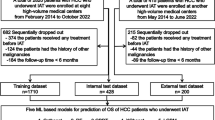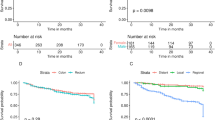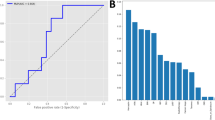Abstract
Cardiotoxicity is a severe side effect for colorectal cancer (CRC) patients undergoing fluoropyrimidine-based chemotherapy. To develop and compare machine learning algorithms to predict cardiotoxicity risk among nationally representative CRC patients receiving fluoropyrimidine, CRC Patients with at least one claim of fluoropyrimidine after their cancer diagnosis were included. The outcome was the 30-day cardiotoxicity from the first day of starting fluoropyrimidine. The machine learning models including extreme gradient boosting (XGBoost), random forest (RF), and logistic regression (LR) were developed using 2006–2011 SEER-Medicare data, and model performances were evaluated using 2012–2014 data. Precision, F1 score, and area under the receiver operating characteristics curve (AUC) were measured to evaluate model performances. Feature importance plots were obtained to quantify the predictor importance. Among 36,030 CRC patients, 18.74% of them developed cardiotoxicity within 30 days since the first fluoropyrimidine. The XGBoost approach had better prediction performance with higher precision (0.619) and F1 score (0.406) in predicting the 30-day cardiotoxicity, compared to the RF (precision, 0.607 and F1 score, 0.395) and LR (precision, 0.610 and F1 score, 0.398). According to the DeLong’s test for AUC difference, the XGBoost significantly outperformed the RF and LR (XGBoost, 0.816 vs. RF, 0.804, P < 0.001; XGBoost vs. LR, 0.812, P = 0.003, respectively). Feature importance plots identified pre-existing cardiac conditions, surgery, older age as top significant risk factors for cardiotoxicity events among CRC patients after receiving fluoropyrimidine. In summary, the developed machine learning models can accurately predict the occurrence of 30-day cardiotoxicity among CRC patients receiving fluoropyrimidine-based chemotherapy.





Similar content being viewed by others
Data Availability
For SEER-Medicare data, data access is available to investigators for research purposes and is required to obtain approval from NCI.
References
FDA. (2019). Highlights of prescribing information for fluorouracil injection. [Internet]. https://www.accessdata.fda.gov/drugsatfda_docs/label/2016/012209s040lbl.pdf
Longley, D. B., Harkin, D. P., & Johnston, P. G. (2003). 5-fluorouracil: Mechanisms of action and clinical strategies. Nature Reviews Cancer, 3, 330–338.
Jin, X., Bai, Y., Gao, L., & Wu, S. (2019). Incidence of and risk factors for cardiotoxicity after fluorouracil-based chemotherapy in locally advanced or metastatic gastric cancer patients. Cancer Chemotherapy and Pharmacology, 84, 599–607.
Khan, M. A., Masood, N., Husain, N., Ahmad, B., Aziz, T., & Naeem, A. (2012). A retrospective study of cardiotoxicities induced by 5-fluouracil (5-FU) and 5-FU based chemotherapy regimens in Pakistani adult cancer patients at Shaukat Khanum Memorial Cancer Hospital & Research Center. The Journal of the Pakistan Medical Association, 62, 430–434.
Peng, J., Dong, C., Wang, C., Li, W., Yu, H., Zhang, M., et al. (2018). Cardiotoxicity of 5-fluorouracil and capecitabine in Chinese patients: a prospective study. Cancer Commun (Lond) [Internet]. https://www.ncbi.nlm.nih.gov/pmc/articles/PMC5953402/
Abdel-Rahman, O. (2019). 5-Fluorouracil-related cardiotoxicity; findings from five randomized studies of 5-fluorouracil-based regimens in metastatic colorectal cancer. Clinical Colorectal Cancer, 18, 58–63.
Kosmas, C., Kallistratos, M. S., Kopterides, P., Syrios, J., Skopelitis, H., Mylonakis, N., et al. (2008). Cardiotoxicity of fluoropyrimidines in different schedules of administration: A prospective study. Journal of Cancer Research and Clinical Oncology, 134, 75–82.
Kwakman, J. J. M., Simkens, L. H. J., Mol, L., Kok, W. E. M., Koopman, M., & Punt, C. J. A. (2017). Incidence of capecitabine-related cardiotoxicity in different treatment schedules of metastatic colorectal cancer: A retrospective analysis of the CAIRO studies of the Dutch Colorectal Cancer Group. European Journal of Cancer, 76, 93–99.
Stewart, T., Pavlakis, N., & Ward, M. (2010). Cardiotoxicity with 5-fluorouracil and capecitabine: More than just vasospastic angina. Internal Medicine Journal, 40, 303–307.
NCCN. (2019) Colon Cancer. NCCN Clinical Practice Guidelines in Oncology. 181.
NCCN. (2019) Rectal Cancer. NCCN Clinical Practice Guidelines in Oncology. Rectal Cancer. 166
Churpek, M. M., Yuen, T. C., Winslow, C., Meltzer, D. O., Kattan, M. W., & Edelson, D. P. (2016). Multicenter comparison of machine learning methods and conventional regression for predicting clinical deterioration on the wards. Critical Care Medicine, 44, 368–374.
Zhang, Z., Beck, M. W., Winkler, D. A., Huang, B., Sibanda, W., Goyal, H. (2018). Opening the black box of neural networks: methods for interpreting neural network models in clinical applications. Ann Transl Med [Internet]. https://www.ncbi.nlm.nih.gov/pmc/articles/PMC6035992/
Van Belle, V. M. C. A., Van Calster, B., Timmerman, D., Bourne, T., Bottomley, C., Valentin, L., et al. (2012). A mathematical model for interpretable clinical decision support with applications in gynecology. PLoS ONE, 7, e34312.
Brick, T. R., Koffer, R. E., Gerstorf, D., & Ram, N. (2018). Feature selection methods for optimal design of studies for developmental inquiry. Journals of Gerontology. Series B, Psychological Sciences and Social Sciences, 73, 113–123.
Lu, H., Gao, H., Ye, M., Wang, X. (2019). A hybrid ensemble algorithm combining adaboost and genetic algorithm for cancer classification with gene expression data. IEEE/ACM Transactions on Computational Biology and Bioinformatics
Zhou, Z.- H. (2012). Ensemble methods: Foundations and algorithms [Internet]. Chapman and Hall/CRC. https://www.taylorfrancis.com/books/9780429151095
Hosni, M., Abnane, I., Idri, A., Carrillo de Gea, J. M., & Fernández Alemán, J. L. (2019). Reviewing ensemble classification methods in breast cancer. Computers Methods and Programs in Biomedicine, 177, 89–112.
Enewold, L., Parsons, H., Zhao, L., Bott, D., Rivera, D. R., Barrett, M. J., et al. (2020). Updated overview of the SEER-medicare data: enhanced content and applications. JNCI Monographs, 2020, 3–13.
Chen, J., Long, J. B., Hurria, A., Owusu, C., Steingart, R. M., & Gross, C. P. (2012). Incidence of heart failure or cardiomyopathy after adjuvant trastuzumab therapy for breast cancer. Journal of the American College of Cardiology., 60, 2504–2512.
Kenzik, K. M., Balentine, C., Richman, J., Kilgore, M., Bhatia, S., & Williams, G. R. (2018). New-onset cardiovascular morbidity in older adults with stage I to III colorectal cancer. JCO., 36, 609–616.
Hershman, D. L., McBride, R. B., Eisenberger, A., Tsai, W. Y., Grann, V. R., & Jacobson, J. S. (2008). Doxorubicin, cardiac risk factors, and cardiac toxicity in elderly patients with diffuse B-cell non-Hodgkin’s lymphoma. JCO., 26, 3159–3165.
Ko, C. W., Dominitz, J. A., Neradilek, M., Polissar, N., Green, P., Kreuter, W., et al. (2014). Determination of colonoscopy indication from administrative claims data. Medical Care, 52, e21–e29.
Lavery, J. A., Lipitz-Snyderman, A., Li, D. G., Bach, P. B., Panageas, K.S. (2019). Identifying cancer-directed surgeries in medicare claims: A validation study using SEER-medicare data. JCO Clin Cancer Inform [Internet]. https://www.ncbi.nlm.nih.gov/pmc/articles/PMC6648680/
Silber, J. H., Rosenbaum, P. R., Clark, A. S., Giantonio, B. J., Ross, R. N., Teng, Y., et al. (2013). Characteristics associated with differences in survival among black and white women with breast cancer. JAMA, 310, 389–397.
Edge, S. B., Compton, C. C. (2010). The American Joint Committee on Cancer: the 7th edition of the AJCC cancer staging manual and the future of TNM. Annals of Surgical Oncology 17, 1471–1474.
Bach, P. B., Guadagnoli, E., Schrag, D., Schussler, N., & Warren, J. L. (2002). Patient demographic and socioeconomic characteristics in the SEER-Medicare database applications and limitations. Medical Care., 40, 19–25.
Chamie, K., Williams, S. B., & Hu, J. C. (2015). Population-based assessment of determining treatments for prostate cancer. JAMA Oncology, 1, 60.
Zou, K. H., James, O. A., & Laura, M. (2007). Receiver-operating characteristic analysis for evaluating diagnostic tests and predictive models. Circulation, 115, 654–657.
DeLong, E. R., DeLong, D. M., & Clarke-Pearson, D. L. (1988). Comparing the areas under two or more correlated receiver operating characteristic curves: a nonparametric approach. Biometrics, 44, 837–845.
Weng, S. F., Reps, J., Kai, J., Garibaldi, J. M., & Qureshi, N. (2017). Can machine-learning improve cardiovascular risk prediction using routine clinical data? PLOS One, 12, e0174944.
Parikh, R. B., Manz, C., Chivers, C., Regli, S. H., Braun, J., Draugelis, M. E., et al. (2019). Machine learning approaches to predict 6-month mortality among patients with cancer. JAMA Netw Open., 2, e1915997.
Wittayanukorn, S., Qian, J., Westrick, S. C., Billor, N., Johnson, B., & Hansen, R. A. (2018). Prevention of trastuzumab and anthracycline-induced cardiotoxicity using angiotensin-converting enzyme inhibitors or β-blockers in older adults with breast cancer. American Journal of Clinical Oncology, 41, 909–918.
Polk, A., Vaage-Nilsen, M., Vistisen, K., & Nielsen, D. L. (2013). Cardiotoxicity in cancer patients treated with 5-fluorouracil or capecitabine: A systematic review of incidence, manifestations and predisposing factors. Cancer Treatment Reviews., 39, 974–984.
Li, C., Ngorsuraches, S., Chou, C., Chen, L., & Qian, J. (2021). Risk factors of fluoropyrimidine induced cardiotoxicity among cancer patients: A systematic review and meta-analysis. Critical Reviews in Oncology/Hematology., 162, 103346.
Smilowitz, N. R., & Berger, J. S. (2020). Perioperative cardiovascular risk assessment and management for noncardiac surgery: A review. JAMA, 324, 279–290.
Raslau, D., Bierle, D. M., Stephenson, C. R., Mikhail, M. A., Kebede, E. B., & Mauck, K. F. (2020). Preoperative cardiac risk assessment. Mayo Clinic Proceedings, 95, 1064–1079.
Arnett, D. K., Blumenthal, R. S., Albert, M. A., Buroker, A. B., Goldberger, Z. D., Hahn, E. J., et al. (2019). 2019 ACC/AHA guideline on the primary prevention of cardiovascular disease: A report of the American college of cardiology/American heart association task force on clinical practice guidelines. Circulation. American Heart Association, 140, e596-646.
Stewart, J., Manmathan, G., Wilkinson, P. (2017). Primary prevention of cardiovascular disease: A review of contemporary guidance and literature. JRSM Cardiovascular Disease. https://www.ncbi.nlm.nih.gov/pmc/articles/PMC5331469/
Blanter, J. B., & Frishman, W. H. (2019). The preventive role of angiotensin converting enzyme inhibitors/angiotensin-II receptor blockers and β-adrenergic blockers in anthracycline- and trastuzumab-induced cardiotoxicity. Cardiology in Review, 27, 256–259.
Ezekowitz, M. D., & Falk, R. H. (2004). The increasing need for anticoagulant therapy to prevent stroke in patients with atrial fibrillation. Mayo Clinic Proceedings, 79, 904–913.
Chan, N. C., & Eikelboom, J. W. (2019). How I manage anticoagulant therapy in older individuals with atrial fibrillation or venous thromboembolism. Blood, 133, 2269–2278.
Hu, C.-A., Chen, C.-M., Fang, Y.-C., Liang, S.-J., Wang, H.-C., Fang, W.-F., et al. (2020). Using a machine learning approach to predict mortality in critically ill influenza patients: a cross-sectional retrospective multicentre study in Taiwan. BMJ Open, 10, e033898.
Elfiky, A. A., Pany, M. J., Parikh, R. B., & Obermeyer, Z. (2018). Development and application of a machine learning approach to assess short-term mortality risk among patients with cancer starting chemotherapy. JAMA Netw Open., 1, e180926.
Acknowledgements
This study was supported by the PhRMA Foundation Predoctoral Fellowship awarded to Dr. Chao Li. This study used the linked SEER-Medicare database. The interpretation and reporting of these data are the sole responsibility of the authors. The authors acknowledge the efforts of the National Cancer Institute (NCI); the Office of Research, Development and Information, CMS; Information Management Services (IMS), Inc.; and the Surveillance, Epidemiology, and End Results (SEER) Program tumor registries in the creation of the SEER-Medicare database.
Funding
This study was supported by the PhRMA Foundation Predoctoral Fellowship awarded to Dr. Chao Li.
Author information
Authors and Affiliations
Contributions
CL: conceptualization, methodology, funding acquisition, investigation, formal analysis, project administration, writing-original draft, and writing-review and editing. CC: data curation, supervision, and writing-review and editing. SN: supervision, and writing-review and editing. LC: Supervision, and writing-review and editing. JQ: conceptualization, funding acquisition, data curation, supervision, project administration, writing-original draft, and writing-review and editing.
Corresponding author
Ethics declarations
Conflict of interest
No other authors declare a potential conflict of interest.
Ethical Approval
The study was approved by the Auburn University institutional review board (IRB).
Informed Consent
Not applicable.
Additional information
Handling Editor: Vincent FM Segers.
Publisher's Note
Springer Nature remains neutral with regard to jurisdictional claims in published maps and institutional affiliations.
Supplementary Information
Below is the link to the electronic supplementary material.
Rights and permissions
About this article
Cite this article
Li, C., Chen, L., Chou, C. et al. Using Machine Learning Approaches to Predict Short-Term Risk of Cardiotoxicity Among Patients with Colorectal Cancer After Starting Fluoropyrimidine-Based Chemotherapy. Cardiovasc Toxicol 22, 130–140 (2022). https://doi.org/10.1007/s12012-021-09708-4
Received:
Accepted:
Published:
Issue Date:
DOI: https://doi.org/10.1007/s12012-021-09708-4




